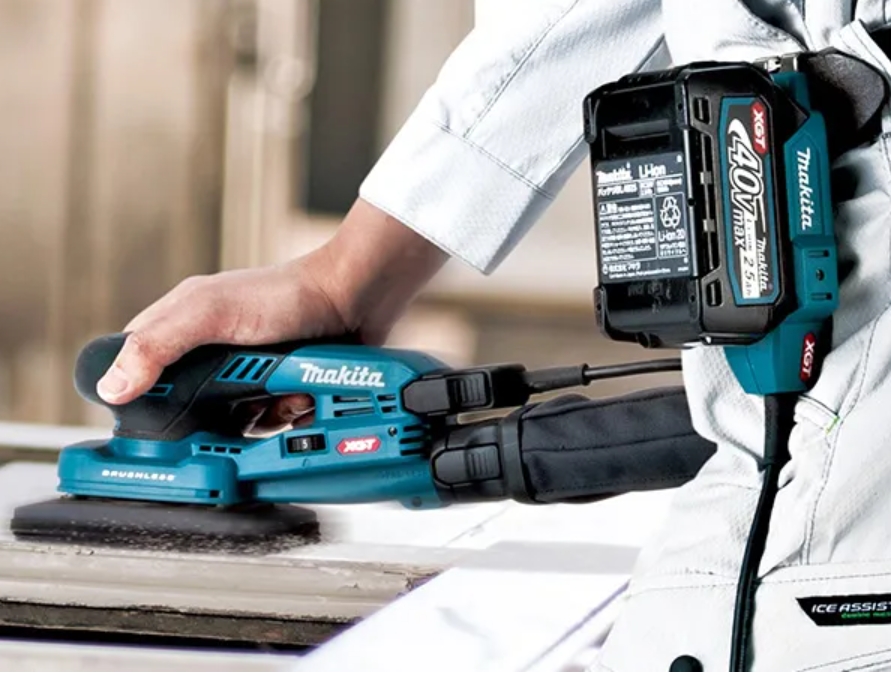Makita launched 2 new sanders as part of their XGT cordless power tool system.
You don’t have to look too closely to see that there’s something very different about them.
The new tools are part of the Makita XGT cordless power tool system, although they’re not exactly cordless.

Both sanders have tethered off-the-tool battery sources, making them more accurately described as battery-powered tools.

The Makita XGT sanders’ battery power adapters are designed to clip to the user’s belt, offloading the attached battery’s size and weight from the tool.
This makes the XGT sanders much more compact and lighter than traditional cordless battery-powered sanders.

There are two versions of the battery connection – one with a 1.6 m (~5.25 ft) cord length, and the other with a 5.0m (~16.4 ft) cord length.

The longer cord length allows for more convenient use with dust extractors, or otherwise where the user doesn’t want the battery hanging off their belt.
Product details suggest that the two lengths of battery adapters are sold separately. It’s unclear whether either is included with the sander.

The new XGT sanders are also AWS-compatible, for wireless activation of compatible Makita dust extractors. The necessary module is presumed to be sold separately, which is the case for other AWS-compatible tools.

There are two new sanders – a random orbit sander (B0001CG), and a finish sander (B005CG).
Rather than simply featuring a different sanding pad, the finish sander has a narrower housing.

Makita outlines numerous benefits over the brand’s existing 18V cordless sanders.
To start, the new Makita XGT random orbit sander is considerably shorter than their 18V sander.

Makita product literature also gives attention to a new low-profile brushless motor that’s presumably specifically engineered for the two new sanders.

The XGT sander also beats the 18V sander on weight, shaving off nearly half off its weight.
This is undoubtedly thanks to Makita engineers moving the battery power source off the tool.

Makita says that the XGT sanders also deliver improved performance and work efficiency.
According to a translation of their claims, the XGT random orbit sander delivers an increase in work efficiency by approximately 70%, and the XGT finish sander approximately 60%, compared to their 18V tools.

The tools are rated to IPX4 dust and water resistance standards.
The B0001CG random orbit sander has a 125mm (5″) pad size, and 5mm orbit diameter. The B0005CG finish or detail sander has an 80 x 130mm pad and 3mm orbit diameter.
Both pads have hook and loop abrasive connections. An adjustable dial allows for speeds from 6,000 to 10,000 RPM.
Makita has announced the new tools to the international market; there has not yet been any news of USA details or availability.
Discussion

This brings to mind Festool’s 18V hybrid-powered sander. Festool’s hybrid sanders can be powered via battery or AC power cord. In either case, the battery or AC adapter is attached right to the tool.
Festool’s focus was on allowing for battery or AC power. Makita’s focus seems to be on reducing tool size and weight for an improved battery-powered sanding experience.
Festool hybrid sanders have a smaller and ergonomically shaped battery that is separate from their 18V cordless power tool system, and it only works with their sanders. The new Makita sanders work with the brand’s XGT batteries.
The new Makita sanders look to have a proprietary connection, but it seems there could be the potential for an AC adapter if there’s enough demand for it.
Maybe there’s also the potential for an 18V or 18V X2 adapter? It doesn’t seem like it would take a lot of engineering work to produce 18V battery-powered versions of these tools.
Still, Makita seems intent on driving customers to their newer XGT system, giving rise to doubts that we’ll see 18V versions of the same sanders. Makita’s 18V random orbit sander launched more than 10 years ago, and a finish sander came out more recently.
While having a belt-mounted battery pack might seem clunky, and maybe even more so with the longer battery adapter, this means that the user experience should be independent of power considerations.
Whether you have a compact battery or Makita’s biggest and highest capacity battery, there shouldn’t be any noticeable changes to the sander’s ergonomics or control.
Then again, if you’re dealing a power cord, it might be easier and more economical to use an AC-powered corded sander, of which there are plenty of excellent low-profile options on the market.
